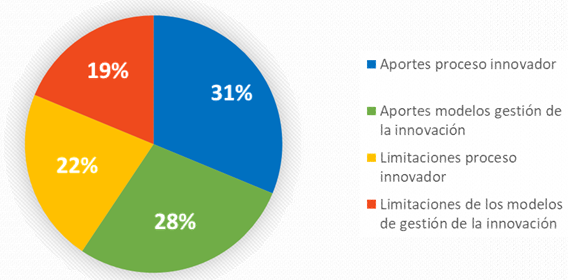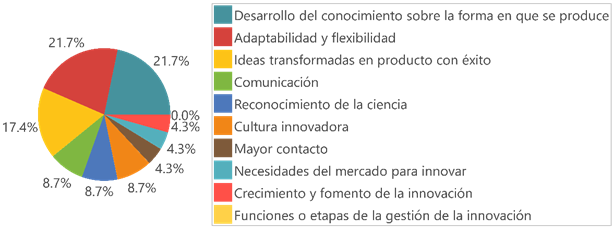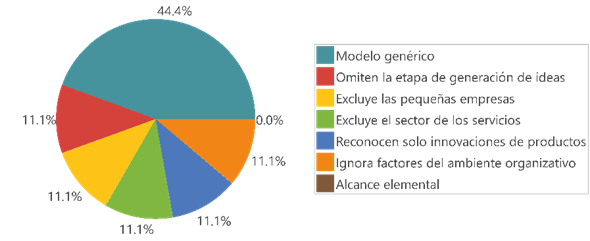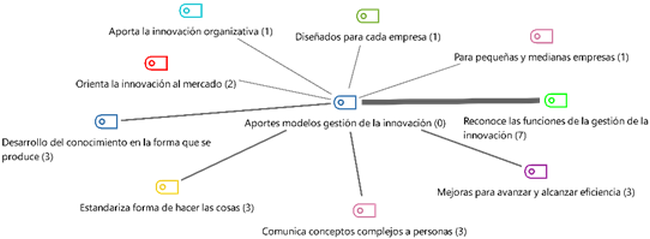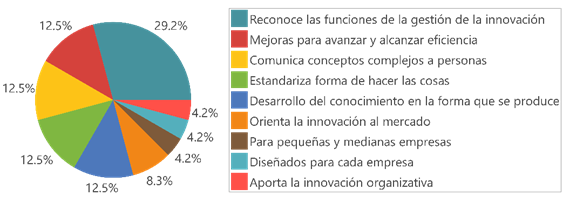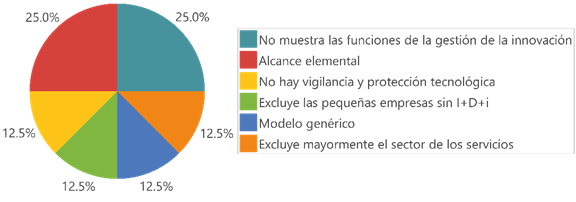Mi SciELO
Servicios Personalizados
Articulo
Indicadores
-
 Citado por SciELO
Citado por SciELO
Links relacionados
-
 Similares en
SciELO
Similares en
SciELO
Compartir
Cooperativismo y Desarrollo
versión On-line ISSN 2310-340X
Coodes vol.12 no.1 Pinar del Río ene.-abr. 2024 Epub 30-Abr-2024
Original article
Models for the management of innovation and the innovative business process. Bibliometric study
1 Empresa de Aplicaciones Informáticas, Desoft. Pinar del Río, Cuba.
2 Universidad de Pinar del Río "Hermanos Saíz Montes de Oca". Pinar del Río, Cuba.
The objective of this work is to carry out a bibliometric study on the most widespread innovation management models and the innovative process in the business field in recent decades. The methodology used is descriptive with a qualitative approach. For this purpose, the bibliographic review was carried out, with the application of the methodology of systematic reviews and the support of the Prisma 2020 Declaration in indexed articles referring to innovation management models and the innovative process, establishing certain selection criteria that allow obtaining the bibliography to study. The results show the different criteria studied that were related and integrated with each other to establish the determining factors of the proposed study such as the limitations and contributions of the models.
Key words: innovation management; innovation; innovation management models; innovation process
Introduction
Innovation management is highly complex for decision makers due to the diversity of: concepts, approaches, models and tools that can be applied. With the necessary multidisciplinary collaboration, teamwork, project work and strategic thinking, which must be present in the stages of opportunity identification, creation and validation of concepts, development and deployment of solutions (Delgado Fernández, 2024).
The world is experiencing a growth in technological and social evolution, which demands the need to assimilate new technologies, work processes and management procedures. Organizations must assume their value creation processes, based on strategies that guarantee development, in response to the demands and needs of the environment and customers, strategies that are derived from research associated with resolving situations that arise and that can influence in the loss of value in their products and/or processes.
It is agreed with Vilá (2011), who states that there are two fundamental ideas: first, developing the capacity to innovate requires a paradigm shift in the way of leading and in the way people act and second, and more importantly, the innovation aims for the top; it is a problem of transformative leadership, which does not allow delegation. Moving towards a fully innovative culture requires a change in management skills and practices that until now have not been key in senior management positions in companies.
In order to promote the innovative culture, an innovation management model is needed that takes into account the characteristics of each company and that allows the current trends of companies in the world to be inserted into the model, taking into account, among others, the basis of the Deming cycle, composed of four phases: plan, do, check and act and the benefits that this cycle brings, among which are greater efficiency and effectiveness, continuous improvement, improved project risk management and ease of decision making (National Standardization Office, 2022). In addition, it improves the generation of new knowledge or technological ideas for the development of new products that can be transferred to all areas to generate benefits through the use of methodologies, procedures that facilitate the development of products, processes or services and the improvement of already existing, recognizing that these methodologies are among the fastest growing strategies for promoting and consolidating innovation (Falcone Treviño et al., 2018).
In this sense, it is worth asking the following: Will there be a single model that explains the management of innovation in organizations? Will the same innovation management model be applicable to any type of organization?
In this regard, in the scientific literature there are different models according to the author who has designed and published them. Barreto Fereira and Petit Torres (2017), Franco Castro et al. (2018), Restrepo Ramírez et al. (2022) have provided a series of explanatory models that allow to visualize the routes and phases involved.
Given the variety of explanatory technologies for innovation, it is of interest to know if there is a definitive general technology that drives the development of innovations adaptable to any organization. Therefore, the objective of this article is to carry out a bibliometric study on the most widespread innovation management models and the innovative process in the business field in recent decades, identifying their characteristics and contributions.
Materials and methods
The research was supported by a set of theoretical level methods based on dialectical materialism. The use of the methodology of systematic reviews, as part of the techniques of documentary analysis and the historical-logical method to analyze the evolution of technologies associated with the management of business innovation, allowed to show the results presented.
The use of the methodology of systematic reviews, hereinafter SR, allowed the analysis of the theoretical and methodological references related to innovation management models. The SRs were made using the Prisma 2020 Declaration, according to Ciapponi (2021) and Page et al. (2021) taking into account the fundamental elements of the methodology, which can provide a synthesis of the state of knowledge in a field, from which future research priorities can be identified, therefore generating various types of knowledge for the different users of the reviews.
To apply the methodology, scientific articles published in journals indexed in the databases Scopus, SciELO, among others, between the years 2016 and 2023 were collected. To access the articles, the Google Scholar search engine was used, and blogs of some authors who have addressed the subject were also used.
In the SR carried out, selection criteria were defined and applied in the studies, among which the following terms appear in the title: innovation management, innovation, innovation management models, innovation process, in addition, that the years of consultation are between 2016 and 2023, that they are in indexed scientific journals and in the case of literature collected in theses, that these are doctoral theses.
Once the references were extracted, only those that met the minimum requirements (selection criteria) mentioned above were selected from among them. With these criteria, it was sought to ensure coherence with the objective set in the research and the question that the review sought to answer, that is, thematic selection criteria.
In the critical analysis of the study, the historical-logical method was applied so that it was possible to identify the main management models of business innovation and the innovative process in the business field, the context in which they are developed and their historical impact. Through the analysis-synthesis technique and the logical process of induction-deduction there were certain characteristics and contributions of the models to understand their essence. With the inclusion and exclusion criteria, the review focused on these studies that, in theory, are those with the most reliable results.
The results were processed using the Zotero bibliographic manager in version 6.0.26. To analyze the articles, the MAXQDA analysis tool was used. Analytics Pro 2020 in version 20.2.1. The texts analyzed with this tool were in open format to achieve the processing of the indicators shown in the figures. Furthermore, the articles consulted are in Spanish.
Results and discussion
The review of the different technologies was done through systematic reviews; for this, it was necessary to define the objective of the research and through the Prisma 2020 Declaration and based on criteria established for the search, innovation management, innovation, innovation management models, innovation process, in addition, the consulted documents were found between the years 2016 to 2023 in Spanish.
In the world there are technologies that are used to manage innovation, among them are those that manage the innovative process itself and those that manage business innovation. For both cases, different formats can be found: models, methodologies or procedures, concentrating this study on models, both for innovative process models and business innovation management models.
When it refers to a management model, it refers of the set of processes, tools and people that an organization uses to apply, in this case, innovation. These are designed to innovate according to the companies' own characteristics. It states that models allow three fundamental actions: communicating complex concepts to other people, standardizing the way of doing things in each phase so that everyone does it the same, and improving the way they do things to continue advancing and gaining efficiency.
For a better analysis of these models, four groups of codes were defined, the limitations and contributions of the innovative process and the limitations and contributions of business innovation management and the authors consulted.
The following figure shows the weight of each group of codes in the analysis carried out.
The coding of the contributions, both for the innovative process and for the management of business innovation with each of the defined subcodes that represent the identified contributions, has the highest percentages, 31 and 28% respectively, that is, it is demonstrated that both groups of models have a level of contributions higher than the limitations that each one may present, which register 22% for the innovative process and 19% for the limitations of business management recognized in the articles analyzed.
In the study carried out regarding the models of the innovation process, these are grouped into five generations. They have evolved from the sixties to date (Barreto Fereira & Petit Torres, 2017; Franco Castro et al., 2018; Restrepo Ramírez et al., 2022). The studied authors agree that the models have a scientific level, highlighting as the most recognized: the linear models among which are the Technology Push and Demand Pull Models and the Traditional Model, Model by Departmental Stages, Interactive Models o Mixed that include the Marquis models (1969), Rothwell and Zegveld model (1985), Kline and Rosenberg model (1985), Integrated Model that includes the fourth generation model Rothwell (1994), Network Model, includes the Rothwell `s Network models (1994) and the London Business Scholl Model, Professor Vijay Kumar `s Toolbox Model.
The analysis of these models of the innovation process shows that each one tries to perfect the previous ones. Each generation of Rothwell models makes new contributions and incorporates elements, in such a way that knowledge about the way in which innovation occurs in organizations has been developed.
Figures 2 and 3 show the ten contributions that were identified in the innovative process models. Figure 2 shows the coding carried out for each contribution; the thicker bar codes mean that they are contributions identified in several models, so they have a representative weight since several authors agree on their identification. Therefore, the most recognized contributions in the models studied are: adaptability and flexibility, in addition, the development of knowledge about the way in which the innovative process is recognized, both contributions are present in five models that represent 21.7%. followed by the contribution associated with ideas transformed into successful products, which are recognized in four models, representing 17.4%.
 Source: MAXQDA 2020
Source: MAXQDA 2020Figure 2 Code and subcode by segments of the contributions of the innovative process models
Contributions such as communication and recognition of science and innovative culture are present in two models for 8.7%; other contributions such as the recognition of greater contact between the parties, the market needs to innovate and the growth and promotion of innovation were addressed in a model, representing 4.3% agreement between the authors consulted.
From what was shown above about the contributions of the models of the innovative process, there is the linear model, which highlights the importance of the development and push of technology and/or science, the linear model Demand Pull that introduces the need for market as a source of generating ideas to innovate as the beginning of the model, maintaining the following stages. However, the model by departmental stages, which is also included among the models of the innovative process, exposes innovation as a linear activity similar to previous models and expresses as a novelty that the idea becomes the input of an R&D&I department and passes through several departments until the final product is obtained. Interactive or mixed models incorporate retroactive communication processes between the various stages.
In the case of network models, they provide greater flexibility and adaptability in organizations, in addition to encouraging an innovative culture, there is greater contact with the organizational environment and greater social collaboration for innovation.
It should be noted that the systemic model of the London Business Scholl of Chiesa exposes that the key tasks, in what today can be considered as the organizational competencies necessary to manage innovation efficiently such as generation of new concepts, development of new products or services, innovation in processes and the acquisition of technology, is one of the most advanced of its time.
Even though these models have made contributions to the innovative process, limitations have also been identified.
The figures shown below show the weight of the seven limitations identified in the models (Figures 4 and 5).
 Source: MAXQDA 2020
Source: MAXQDA 2020Figure 4 Code and subcode by segments of the limitations of the innovative process models
In both figures it can be seen that, to date, a single model of the innovation process has not been developed, that is, generic models predominate, representing a 44.4% coincidence among the authors consulted.
Existing models focus on product innovations without taking into account the remaining types of innovations, that is, organizational processes and marketing. In addition, they are aimed at the manufacturing sector, excluding the service sector.
Most models are aimed at large companies, which have resources and have an R&D&I department, without taking into account smaller companies, which do not have departments for this activity; but they need models with greater agility and adjusted to their needs.
Most omit a determining stage such as the generation of ideas and exploration, this being the stage that provides the raw material for the innovative process. Some models such as Concomitance, although it incorporates some interactions with the environment, ignore other factors of the organizational environment such as new government regulations.
A similar analysis is presented on business innovation management models in which various approaches are observed, among which are the basic functions of innovation management: inventorying, monitoring, evaluating, optimizing and protecting those that the author recognizes as an innovation management model.
Amores Bravo (2015), who shares the study of other authors, recognizes the innovation management models, among which are the Innovation Management Functions Model, the CIDEM Model or the Generalitat de Catalunya Innovation Management Model (2002), UNE 166002 Management systems of R&D&I and the COTEC Model (2011). Others, such as the Management Model of Kaplan and Norton (2002), Model in the Services Sector (MIS) (2007), IMP3rove Model of the European Union (2008), GI PYMIS Model of the City of Guayana (2010), Innovation Model in a box, Model of Tom Kelley (Manager of IDEO), Model of Elaine Dundon (founder of The Innovation group Consulting Inc.) are also analyzed in this study.
In the bibliometric study carried out on the business innovation management models mentioned above, it is possible to identify, like the models of the innovative process, common contributions and weaknesses in most of the models (Figure 6).
These models are focused on the manufacturing sector and do not include, for the most part, the services sector, which has experienced sustained growth in recent decades (Figure 7).
In the coding of business innovation management models, nine contributions were identified, where recognition of innovation management functions has the highest percentage of weight with 29.2%. Furthermore, this contribution is recognized in seven models by the different authors consulted.
Contributions related to improvements to advance and achieve efficiency, communication of complex concepts to people, standardization in the way of doing things and development of knowledge in the way innovation is produced represent, each of them, the 12.5% of weight and are recognized in three identified models.
Market-oriented innovation represents 8.3% and was identified in two models based on the authors' criteria analysis.
Each model contributed to the management of business innovation, in the case of the model of basic functions of innovation management, it lays the foundations for the different management models while the UNE 166002 model identifies four critical variables of innovation management: the definition of the R&D&I policy, the tools to be used, the execution of R&D&I and the management of R&D&I.
The Kaplan and Norton model is one of the best known, in its Balanced Scorecard four fundamental internal perspectives are proposed, the innovation management process being a core process and the model shows it in three fundamental processes: identification of opportunities, project portfolio management, design and development, and product launch to market.
However, the CIDEM model or Generalitat de Catalunya Innovation management model guides innovation to the market, although it includes product innovation; the model considers organizational innovation as a contribution and as a step forward the model is presented in the Services Sector (MIS), it is the specific model for this sector because there were only models for manufacturing.
Another contribution that is identified in the GI PYMIS model of Guayana City (2010) is used for small and medium-sized companies, something that was not found in the other models, although it is exclusive to companies in this city.
The COTEC model (2011) is one of the most complete and well-known models. It includes the functions of innovation management, but also defines three foundations where the center of each one is innovation to achieve an innovative company.
The Innovation in a box model is a revolutionary model because it takes the best of each model, but includes strategic, operational and accelerator processes, highlighting agile methodologies and hybridization in the accelerator process to the open innovation. These accelerators, as the word implies, simplify and accelerate business innovation.
Regarding the limitations identified in these models, figures 8 and 9 show the following results.
As shown in the figures, although these models recognize the functions of innovation management, they do not show it in the model itself and it is recognized by several authors as representing 25% as well as the elemental scope of some of the models among of them, that of basic functions of innovation management, which has an elementary scope, and the CIDEM model or the Generalitat de Catalunya Innovation Management Model, which does not explicitly show in its four macro functions those of innovation management, as well as the model in the Services Sector (MIS), a generic model and although it recognizes seven functions, it does not explicitly show those of innovation management.
The UNE 166002 model and the model in the Services Sector (MIS), which, although the first is compatible with other models such as quality and the environment, both are generic models.
The Kaplan and Norton model is one of the best known, but, although it recognizes innovation management as a core process, it does not show technological surveillance and protection processes.
IMP3rove models of the European Union (2008), the model of Tom Kelley (Manager of IDEO) and that of Elaine Dundon (founder of The Innovation group Consulting Inc.) are generic models that are directed at the market environment from different angles, as is the case of Tom Kelley's model, which does so from observation.
The GI PYMIS model of the City of Guayana (2010) is a model with a limited scope because it was designed based on the companies of the City of Guayana.
From the study of the models of the innovative process and management of business innovation, it can be concluded that each of them tries to perfect the previous ones, strengthening the weaknesses, making new contributions and incorporating perspectives and alternatives, in such a way that it has been developing knowledge about the way in which innovation occurs in organizations. The models of the innovative process, to date, are not generalizable and it is almost impossible to achieve a single model since human creativity is infinite. Many of them focus on obtaining product innovations, leaving aside other types of innovations, such as processes, organizational methods and marketing methods, and they also leave out the service sector.
Most of the models are oriented towards large companies, which have resources and have R&D management, leaving aside smaller companies that do not have this type of department, which leaves an interesting gap for future research that aims to promote innovation in small and medium-sized companies, creating models with greater agility and adjusted to their needs.
In conclusion, it is important to highlight that for the analysis of innovation there is not a single model, but rather, both for the innovative process and for the management of innovation, there are several models that can be applied in the company, seeking to adapt the situation internal or external to the organization and that cause an invention to be produced that aims to take advantage of opportunities in the market or enhance the productivity of the company at a given time.
Referencias bibliográficas
Amores Bravo, X. (2015). La gestión de la innovación en las empresas de servicios intensivas en conocimiento tecnológico (t-KIBS) de Cataluña [Doctorado en Turismo, Derecho y Empresa, Universitat de Girona]. https://www.tdx.cat/handle/10803/380897 [ Links ]
Barreto Fereira, J. R., & Petit Torres, E. E. (2017). Modelos explicativos del proceso de innovación tecnológica en las organizaciones. Revista Venezolana de Gerencia, 22(79), 387. https://doi.org/10.31876/revista.v22i79.23028 [ Links ]
Ciapponi, A. (2021). La declaración PRISMA 2020: Una guía actualizada para reportar revisiones sistemáticas. Evidencia, actualización en la práctica ambulatoria, 24(3), e002139. https://doi.org/10.51987/evidencia.v24i4.6960 [ Links ]
Delgado Fernández, M. (2024). Modelos de gestión de la innovación: Conceptos, enfoques, normas y tendencias. Ingeniería Industrial, 45(1), 1-10. https://rii.cujae.edu.cu/index.php/revistaind/article/view/1258 [ Links ]
Falcone Treviño, G. F., Jiménez Galán, J. L., Tinajero Mallozzi, Z. L., & Serna Hinojosa, J. A. (2018). Gestión de Innovación en Negocios. Vinculatégica EFAN, 3(3), 463-478. https://www.researchgate.net/publication/360207848_Gestion_de_Innovacion_en_Negocios [ Links ]
Franco Castro, A., Zartha Sossa, J. W., Solleiro, J. L., Montes, J. M., Vargas Martínez, E. E., Palacio Piedrahita, J. C., & Hoyos Concha, J. L. (2018). Propuesta de modelo de gestión de innovación para una empresa de ventas al consumidor final. Revista Lasallista de Investigación, 15(1), 75-89. https://doi.org/10.22507/rli.v15n1a8 [ Links ]
Oficina Nacional de Normalización. (2022). Gestión de la I+D+i: Requisitos del sistema de gestión de la I+D+i (NC 1307). Oficina Nacional de Normalización. [ Links ]
Page, M. J., McKenzie, J. E., Bossuyt, P. M., Boutron, I., Hoffmann, T. C., Mulrow, C. D., Shamseer, L., Tetzlaff, J. M., Akl, E. A., Brennan, S. E., Chou, R., Glanville, J., Grimshaw, J. M., Hróbjartsson, A., Lalu, M. M., Li, T., Loder, E. W., Mayo Wilson, E., McDonald, S., … Alonso Fernández, S. (2021). Declaración PRISMA 2020: Una guía actualizada para la publicación de revisiones sistemáticas. Revista Española de Cardiología, 74(9), 790-799. https://doi.org/10.1016/j.recesp.2021.06.016 [ Links ]
Restrepo Ramírez, C. G., Sepúlveda Rivillas, C. I., & Uribe Castro, J. (2022). Fuentes de financiación para la innovación, según grado de innovación de las empresas de los sectores servicios y comercio en Colombia. Revista CEA, 8(18), e1968. https://doi.org/10.22430/24223182.1968 [ Links ]
Vilá, J. (2011). Cultura innovadora: Valores, principios y prácticas de primeros ejecutivos en empresas altamente innovadoras. En Innovación. Perspectivas para el siglo XXI. BBVA. https://www.bbvaopenmind.com/libros/innovacion-perspectivas-para-el-siglo-xxi/ [ Links ]
Received: October 13, 2023; Accepted: March 28, 2024











 texto en
texto en 

